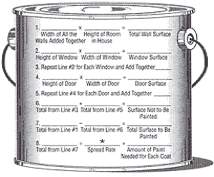A little paint goes a very long way and gives you the biggest bang for your buck – and no matter how large or small your project, knowing how much paint to buy in advance will save you valuable time and money. It’s an easy process involving 3rd grade math skills – which I know we have brushed up on over the years while helping our kids with their homework.


To find out how much paint you’ll need for your specific room, first determine the overall square footage of the area you intend to paint – from walls – ceilings – windows – doors and trim.
Measure the length of all walls you intend to paint (from end to end) and multiply them by their overall height (from floor to ceiling) to determine the wall’s square footage and repeat the process for each a surface.
Paint Tips
- Typically a gallon of paint will cover a surface area of 350 – 400 square feet. (Check the manufacturer’s recommendation on the label)
- A standard size door occupies 20 square feet of space.
- A single average sized window typically occupies approx.15 square feet and an average of 7.5 square feet of paint to cover the trims and sashes.
- New drywall and unfinished materials will require a primer and at least one finished coat– as unprepared surfaces are porous and will absorb most of the first coat.
- To ensure a quality job always specify a primer plus two coats.
- When painting over a dark color factor in two coats of paint.
- Buy more paint than you think you’ll need. It will help with dye lot consistency and leave you with extra material for those invariable touch ups.
Estimating and Measuring
- Measure the length of all walls you intend to paint (from end to end) and multiply them by their overall height (from floor to ceiling) to determine the wall’s square footage.
- Subtract the square footage of any doors and windows in the space from the room total.
- Now that you’ve determined the paint-able wall surfaces, divide that wall area by 400 (the square foot coverage from each gallon) to determine the number of gallons you’ll need to paint your walls.
- Remember to double the amount for two coats.
- Do the same exercise for the ceiling (tip: your floor area is the same measurement as your ceiling area).
- Measure the length of all trims, baseboards, coves and moldings in linear feet – and multiply it by .5 for a safe (6”) measurement of coverage. (Paint goes a long way here).
Next decide which finish, brand and color to buy.
Paint Finishes
Flat Finish:
- Absorbs light and is very forgiving in hiding small wall imperfections.
- Suitable for low traffic interior spaces.
- Poor choice in kitchens, baths playrooms and children’s bedrooms as it doesn’t wipe down well.
Eggshell Finish.
- Similar to matte with a slight sheen as it dries.
- Great choice for interiors and washes down much better than flat.
- Can show slight imperfections in the walls.
- A better option for kids rooms.
Satin Finish.
- Has a smooth shine and is very bright and reflective.
- Wonderful in contemporary homes with perfect wall construction.
- Shows every imperfection.
- Works well for trims, baseboards and moldings.
Semi-Gloss Finish.
- Quite glossy and are used mostly in kitchens, baths since they cleans very easily.
- The higher the sheen the more wipe-able and durable the material.
- Typically used on all trims, doors, baseboards and moldings.
Glossy Finish.
- Used in high contemporary interiors and on modern cabinetry and furniture.
If you still need some extra help or want to double check your calculations, The Benjamin Moore Paint Calculator will help you out.
Stay Inspired!

Please leave your questions or comments below this post, and fill out the form on the right hand side of this page to receive your free copy of my special report: “15 Money Saving Strategies When Planning Your Home Renovation”

